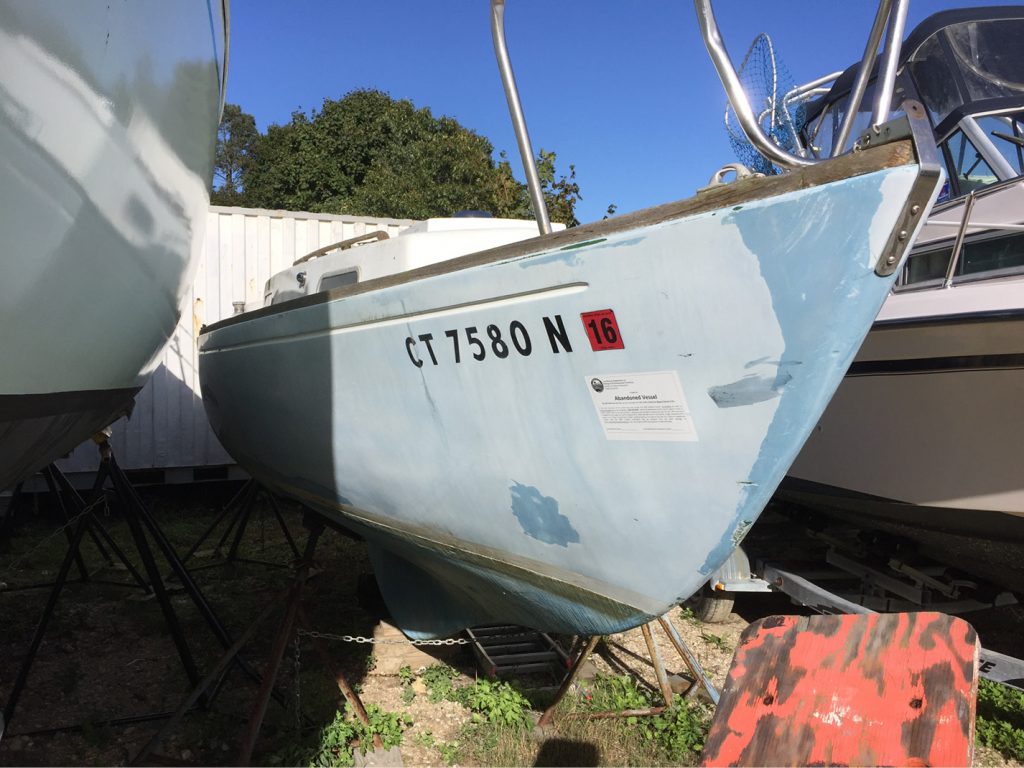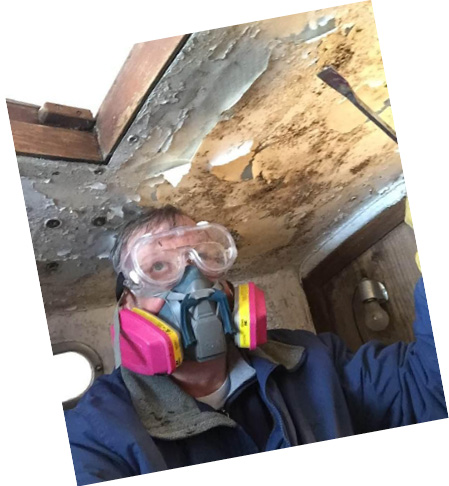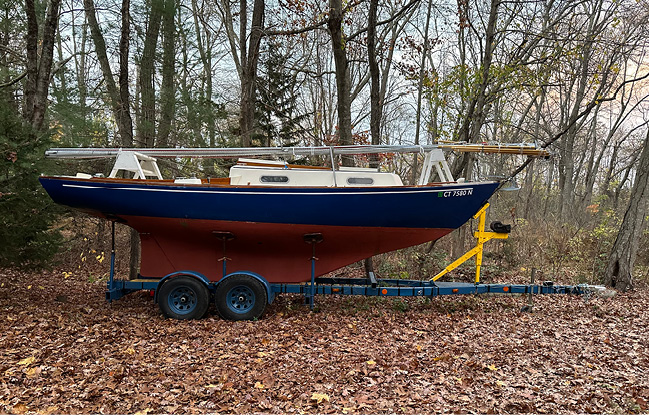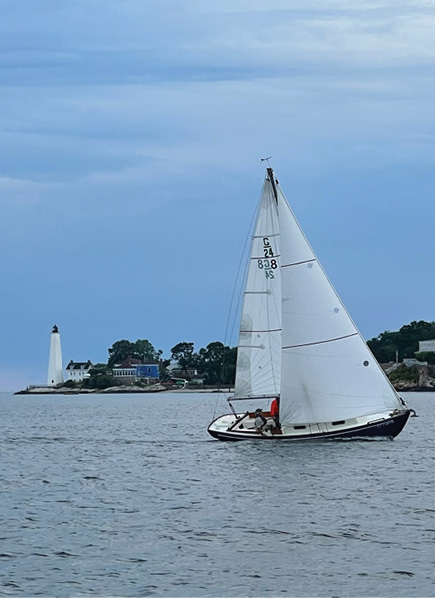Story & photos by Dave Hemenway
In fall 2018, I was discussing the state of the world with friends at my favorite boatyard on the Thames River near New London, CT. I was lamenting that another season had passed without me completing Tenacity, my 36-foot Dickerson yawl that I have owned for over thirty years and have done extensive work on, but never seem to complete to my satisfaction.
In addition, I was longing for a simpler smaller boat that was easier to sail and cheaper to maintain than my beloved larger boat. My boatyard friends at Boating on the Thames were complaining that they had more demand for winter storage than they had space. They wished they could remove three junk boats that had been abandoned by their owners and were taking up yard space. I asked which boats they were talking about and they showed me the three boats.

(Above) Freedom as found (Below) Dave digs in. Repairing the Greenwich 24’s foredeck was the biggest part of this revival.
One was an Ericson 27 that was too far gone to fix, but had a solid dual axle trailer. Another, a Seafarer 23, was in rough but salvageable shape, on a reasonable trailer. The third was a Greenwich 24, # 98, named Freedom that was full of water and had a weak deck, but was otherwise salvageable.
 I have a weak spot for Greenwich 24s because they are great boats that sail well and look good. I owned a green one in the 1970s and enjoyed her. A good friend of the family had owned another one that he loved and we enjoyed sailing her on the Hudson River in the late 1960s. Allied Boat Company in Catskill, NY made 106 of these boats before selling the molds to Cape Dory which turned the basic hull design into the very successful Cape Dory 25.
I have a weak spot for Greenwich 24s because they are great boats that sail well and look good. I owned a green one in the 1970s and enjoyed her. A good friend of the family had owned another one that he loved and we enjoyed sailing her on the Hudson River in the late 1960s. Allied Boat Company in Catskill, NY made 106 of these boats before selling the molds to Cape Dory which turned the basic hull design into the very successful Cape Dory 25.
I thought about the situation and developed a plan. I proposed to the boat yard that I would remove all three boats and trailers if they would give me ownership of the Ericson’s trailer, the Seafarer 23 and its trailer, and the Greenwich 24. We would recycle the bigger boat over the winter: I would take the parts to the town recycling center and the yard would sell the lead keel. I would immediately remove the Seafarer 23 and trailer. I rehomed her to a person who refurbished her and sails her on the Chesapeake Bay. I would work on the Greenwich 24 over the winter and have her out of the yard by end of the following summer, hopefully on the Ericson 27’s trailer which would work well for the Greenwich 24. We agreed that this was a win-win for all and we shook hands on it.
As you might expect, the work on Freedom took much longer than I’d anticipated, but the results were also better than I dreamed of. The first thing I did was to drill a drain hole in her bottom so the water down below, which was more than a foot deep, would drain out. Almost all of the boats that I have refurbished were significantly harmed by water getting down below and doing significant damage. This boat just needed to be cleaned up and repainted down below. I was surprised that the main bulkhead was serviceable since this is often a problem in boats that have suffered from water intrusion into the cabin.
Freedom’s foredeck was her most challenging area since a good part of it had to be re-cored. I took a top-down approach by cutting off the deck and replacing most of the foredeck’s rotten balsa core with small pieces of plywood bedded in WEST System epoxy. Luckily, the deck’s inner liner was still intact and served as a good base for the new core. Fiberglassing the whole foredeck area was easy and resulted in a good, strong deck – not perfect, but good enough with a non-skid surface which hid her imperfections. All the woodwork needed to be refurbished, which was accomplished in July before an August launch. Varnishing in hot weather was a challenge and resulted in some areas that had to be redone the following year.

With fresh paint top and bottom, rejuvenated brightwork and resting in a restored trailer, Freedom awaits her first relaunch in many seasons.

The author says Freedom is easily handled, a delight to sail, and a solid boat.
While the repairs were labor extensive, approximately 100 hours, they cost me less than $1,000. I enjoy saving old boats, and knowing the true condition of boats that I sail. I need to know my boats before I’m comfortable sailing them. I sailed Freedom for three months in fall 2019 and brought her to my home on the Ericson’s trailer that I had refurbished with new brakes and paint.
I have now sailed Freedom for several years and enjoy her as she is easily handled, a delight to sail, and a solid boat. She has been a fun boat with her smaller sails and lighter displacement than Tenacity, my 36-foot yawl. Freedom’s mainsail weighs about fifteen pounds – much lighter and more manageable than Tenacity’s heavy mainsail. I am continuing my work on Tenacity and hope to get her completed by next spring.
In the meantime, it’s been great to have a serviceable, easy to sail substitute, which has reduced the stress of getting Tenacity completed. In the last few years, I have increased my enjoyment of working on Tenacity because I removed the incessant desire to go sailing ASAP. In addition, it was satisfying to help solve a space problem for the Boating on the Thames, save two repairable boats, and properly recycle the unrepairable boat.
Fun is???? ■
Dave Hemenway lives in Eastern Connecticut and sails out of Thames Yacht Club in New London. He’s been sailing and messing about in boats for his whole life and has recreationally sailed Finns on and off since the 1970s. His primary cruising boat is a Dickerson 36 yawl that he has maintained and improved for 35 years. Since his retirement from higher education, he has worked at Cappy’s Boat Shop where he reports to his dog, Cappy.




